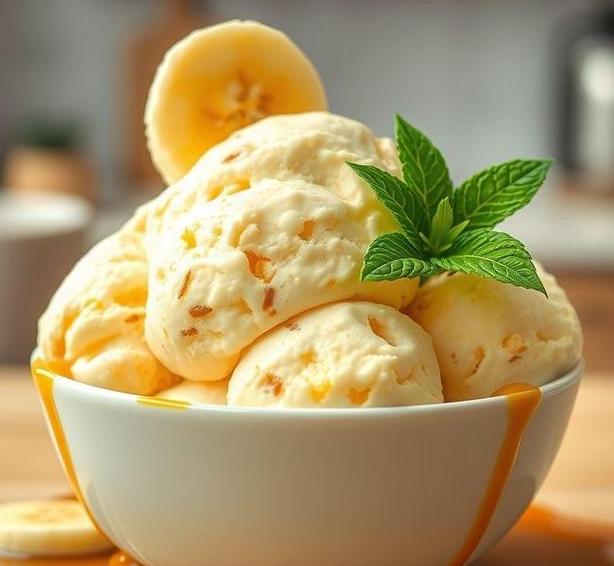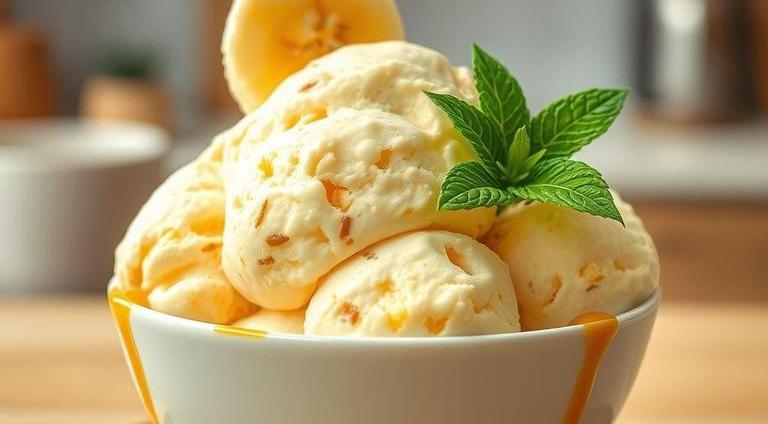Banana ice cream-a sweet, creamy, and refreshing treat-has garnered quite a following among dessert lovers, especially those who prefer natural, fruity flavors. Whether you’re someone who enjoys the pure essence of ripe bananas in their ice cream or you’re more into creative twists like chocolate chips or nuts, there’s no denying that banana ice cream hits the spot. But like all ice cream, banana ice cream comes with its own set of challenges, especially when it comes to storing and making sure it doesn’t go bad too quickly. So, the big question is: Can banana ice cream go bad?
Yes, it certainly can! Like any other perishable food, banana ice cream has a shelf life, and if it’s not stored properly, it can go from a frozen delight to a mushy, tasteless mess. So, let’s dive into the details of what can happen to your favorite frozen treat and how you can keep it fresh and safe to eat for as long as possible.
Can Banana Ice Cream Go Bad?
Absolutely, banana ice cream can go bad. While ice cream’s freezing temperature significantly extends its lifespan compared to fresh foods, the quality of the ice cream deteriorates over time. Several factors can contribute to this decline:
- Freezer Burn: If your ice cream is exposed to air in the freezer, ice crystals can form on the surface, leading to freezer burn. This changes the texture and flavor, making it unappetizing.
- Spoilage: While rare, if banana ice cream isn’t stored properly or has been left out for too long, bacteria and mold can begin to grow. This is especially true if the ice cream has thawed and refrozen multiple times.
- Oxidation: Over time, the natural sugars in the bananas may break down, leading to an off-taste and change in texture. This can also affect the vibrant flavor banana ice cream typically has, making it seem more bland or even sour.
So, while banana ice cream doesn’t go bad in the same way fresh produce does (i.e., with a quickly noticeable, obvious spoilage), it certainly does lose its appeal and may become unsafe to eat.
Shelf Life For Banana Ice Cream

The shelf life of banana ice cream depends on a few important factors like how it’s stored, the type of ingredients, and whether it’s homemade or store-bought. Here’s a quick breakdown:
-
Homemade Banana Ice Cream
Generally speaking, homemade banana ice cream tends to have a shorter shelf life because it lacks preservatives. It will last about 1-2 weeks in the freezer if stored properly.
-
Store-Bought Banana Ice Cream
Commercially produced banana ice cream can last 3-4 months in the freezer when stored at a consistent, low temperature (ideally 0°F or -18°C). This is because it usually contains stabilizers and preservatives that help keep the ice cream fresh longer.
However, best by or use by dates on store-bought versions are important to check because the quality might degrade even if it’s technically still safe to eat after the listed date.
Common Signs Of Spoilage
Banana ice cream doesn’t spoil overnight, but there are some key signs you should look out for that indicate it may have gone bad:
-
Change In Texture
If the ice cream has turned icy or grainy, it’s likely suffered from freezer burn. This usually occurs when the ice cream has been in contact with air, causing water crystals to form. While it may not make you sick, it certainly doesn’t offer the creamy texture you want in a good scoop of ice cream.
-
Off Smell
One of the clearest signs that banana ice cream has gone bad is an unpleasant or sour smell. This could indicate that the bananas have oxidized or that the dairy in the ice cream has spoiled. If it doesn’t smell like fresh banana, it’s best to toss it.
-
Odd Taste
If the ice cream has an off-taste or a strange aftertaste, it could mean the flavor has degraded. The banana flavor might turn sour or bland, and you might taste an off-note due to the aging process. If it tastes wrong, it’s not worth the risk.
-
Discoloration
Over time, banana ice cream may change color, especially if it’s been in the freezer for a long time. If you notice that it’s taken on a brown or grayish hue, it’s likely that the bananas have started to oxidize, which may affect the flavor and quality.
-
Excessive Ice Crystals
Ice crystals forming inside the container may indicate that the ice cream has melted and refrozen multiple times. This can happen if the ice cream is frequently taken in and out of the freezer, or if it was never sealed properly. Excessive ice crystals mean the texture will likely be less smooth, and you may experience a more icy mouthfeel than a creamy one.
How To Store Banana Ice Cream?

Storing banana ice cream correctly is crucial to preserving both its taste and texture. Follow these tips to ensure your frozen treat stays at its best for as long as possible:
-
Proper Sealing
If you’ve got homemade banana ice cream or store-bought ice cream in an open container, make sure to seal it tightly. Use plastic wrap or parchment paper to press directly against the surface of the ice cream before closing the lid. This minimizes air exposure and prevents freezer burn.
-
Consistent Freezing Temperature
Always store your ice cream in the coldest part of the freezer, away from the door. Opening and closing the freezer frequently causes temperature fluctuations that can lead to melting and refreezing, which will degrade the ice cream’s quality.
-
Use An Airtight Container
Transfer your homemade banana ice cream to an airtight container if you’re not going to finish it immediately. This helps protect it from air, which can cause both freezer burn and loss of flavor.
-
Label And Date
It’s always a good idea to label your ice cream containers with the date you made or opened them. This way, you can keep track of how long the ice cream has been in the freezer and avoid eating it after it’s past its prime.
-
Don’t Leave It Out
Don’t leave your banana ice cream sitting out on the counter for more than a few minutes. If it melts and then refreezes, it could lead to changes in texture and the formation of ice crystals. If you’ve accidentally left it out too long, it’s better to discard it than risk eating potentially unsafe ice cream.
Expert Tips
-
Make Small Batches
If you’re making banana ice cream at home, try making smaller batches so you don’t have to store it for too long. Fresh banana ice cream tastes the best within the first few days of making it, so enjoy it soon after it’s made.
-
Freeze In Portions
Instead of freezing your banana ice cream in one large container, freeze it in smaller portions. This way, you only take out as much as you plan to eat, which reduces the risk of it melting and refreezing.
-
Avoid Refreezing
While it’s tempting to refreeze leftover banana ice cream after a scoop, it’s best to avoid doing this. Refreezing can compromise the texture and quality. If you can’t finish the entire pint, consider dividing it into smaller portions to eat at different times.
FAQs
Can Banana Ice Cream Go Bad If It’s Left Out At Room Temperature?
Yes, banana ice cream can go bad if left out at room temperature for too long. The USDA recommends that ice cream should not be left at room temperature for more than 2 hours, as it can cause bacterial growth and result in foodborne illness.
How Long Does Banana Ice Cream Last In The Freezer?
Banana ice cream can last for 2 to 3 months in the freezer when stored properly. To ensure its longevity, it should be kept in an airtight container to prevent freezer burn.
What Are The Signs That Banana Ice Cream Has Gone Bad?
Signs that banana ice cream has gone bad include a change in color, an off or sour odor, ice crystals forming on the surface, or a change in texture. If it has an unusual taste or feels excessively hard or icy, it may have gone bad.
Does Banana Ice Cream Spoil Faster Than Other Flavors?
Banana ice cream may spoil slightly faster than other flavors due to its high moisture content and natural sugars. These factors can promote the growth of bacteria or mold if not stored properly.
Can I Eat Banana Ice Cream If It Has Melted And Refrozen?
It is not recommended to eat banana ice cream that has melted and been refrozen. The texture can be compromised, and there is a risk of bacterial contamination if it was left at an unsafe temperature during the melting process.
How Can I Tell If Homemade Banana Ice Cream Has Gone Bad?
Homemade banana ice cream may spoil faster than store-bought varieties. Check for a sour smell, discoloration, freezer burn, or a change in texture. Additionally, if it was left out for more than 2 hours, it should be discarded.
Does Banana Ice Cream Need To Be Refrigerated?
No, banana ice cream should not be refrigerated. It should always be stored in the freezer to maintain its texture and prevent spoilage. Refrigeration may cause the ice cream to melt and lose its consistency.
Can I Store Banana Ice Cream In A Plastic Container?
Yes, banana ice cream can be stored in a plastic container, but it is important to ensure that the container is airtight. This will help preserve its flavor and prevent freezer burn.
Can Banana Ice Cream Be Stored For A Year?
While banana ice cream can be stored for up to 2-3 months in the freezer, it is generally not advisable to keep it for a year. Over time, the flavor and texture will degrade, and freezer burn may occur.
What Happens If I Eat Expired Banana Ice Cream?
Eating expired banana ice cream can lead to foodborne illness, especially if it has been improperly stored or has developed signs of spoilage like mold, off smells, or changes in texture. It’s best to discard any ice cream past its expiration date.